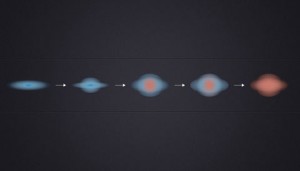Astronomers have found massive galaxies 3 billion years after the Big Bang that are dying from the inside out.
The most massive galaxies in today’s universe are bulbous ellipticals easily 100 times the mass of our spiral Milky Way. These galaxies are essentially “red and dead” — they built up about 80% of their stars more than 6 billion years ago, so any stars shining today are old and rust-colored. They generally have no star formation today.
But 10 billion years ago, at the peak of star formation across the cosmos, these galaxies were ablaze with new, young stars. Between then and now, those stars fizzled out.

Credit: ESA / Hubble and ESO
Last year, two teams found compact, star-forming galaxies in this early cosmic period. Stars in these galaxies are packed as densely as those in so-called compact cores, galaxies in the early universe 10 times the mass of the Milky Way and where star formation has already ceased. That correlation suggests the star-forming compact galaxies became the compact cores. They in turn likely grew into today’s most massive ellipticals by usurping stars from much smaller galaxies, accreting stars onto their outskirts as they tore up and ate their smaller siblings.
But it seems there’s more than one way to grow a big galaxy.
In the April 17th Science, Sandro Tacchella (ETH Zurich, Switzerland) and colleagues report their analysis of 22 star-forming galaxies 10 to 11 billion years ago (average redshift 2.2). These galaxies are not as dense as the compact cores, but the most massive rival them in number of stars. Using images from the Hubble Space Telescope and spectra from the SINFONI instrument on the ESO’s Very Large Telescope in Chile, the team tracked star formation inside the galaxies and found that, in the most massive ones, star formation is shutting down — and from the inside out. Essentially, these massive galaxies contain dead centers surrounded by star-forming envelopes.
These galaxies, unlike the compact ones, churn out stars for longer, retaining a youthful glow for another 2 or 3 billion years. So instead of beefing up their edges by merging with punier galaxies, they grew by forming their own stars. By about 7 billion years ago (redshift of 1), they’ll also be red and dead.
At that point, it’s hard to distinguish which galaxies started out as compact cores and which ones started with an extended, star-forming envelope, says Guillermo Barro (University of California, Santa Cruz), who helped discover the early, compact galaxies reported last year. Essentially, there are two distinct galactic breeds that can both grow into today’s massive ellipticals.
Tacchella’s team doesn’t know why their galaxies are dying inside-out, but the astronomers suspect it’s an internal process. Perhaps a black-hole-spurred outflow from the galaxies’ centers quenches star formation in the inner regions — the most massive galaxies the team looked at do have fast nuclear outflows. Or perhaps star formation shuts off when the local environment hits a critical density of stars — the observations confirm that the local stellar density is very high when the shutdown starts. For now it’s a chicken-and-egg question.
Reference: S. Tacchella et al. “Evidence for mature bulges and an inside-out quenching phase 3 billion years after the Big Bang.” Science, April 17, 2015.
 2
2









Comments
postrevolutionary
April 17, 2015 at 4:09 pm
Or perhaps it'll be true until the next team of researchers says it's not.
You must be logged in to post a comment.
April 18, 2015 at 11:05 pm
AN INTERESTING HYPOTHESIS WORTHY OF CONSIDRATION BUT I TOO WOULD LIKE TO SEE OTHER ASTRO PHYSICISTS COMMENTS THAT MIGHT STRENGTHEN OR WEAKEN THE THEORY. MY OWN KNOWLEDGE LEVEL ON THE SUBJECT IS MINISCULE.
You must be logged in to post a comment.
You must be logged in to post a comment.